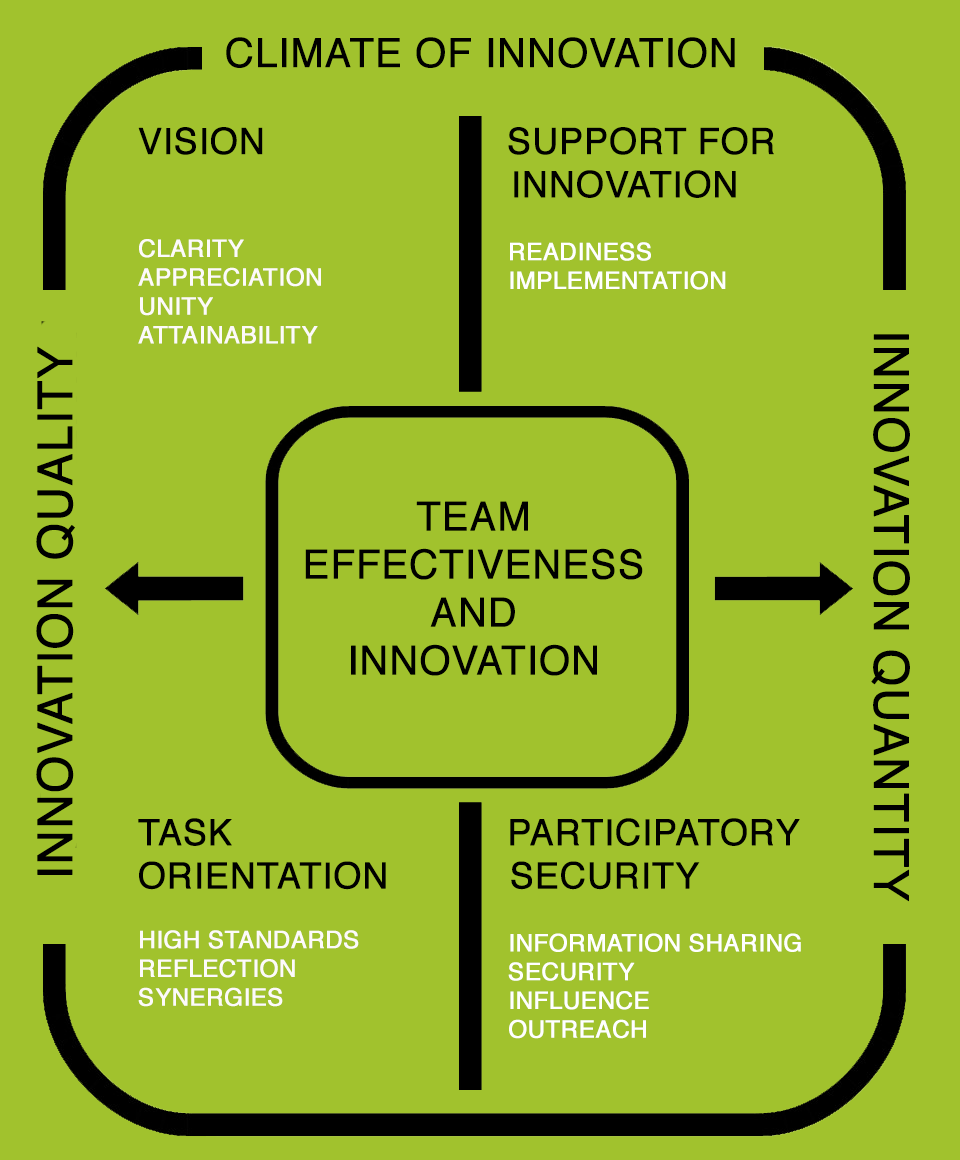Climate of innovation in teams
The focused development of an innovation climate
No matter whether before, during or after the Corona period, innovation will always be a key success factor for companies. In many industries – including the energy industry, in which I am active – it is becoming increasingly important, especially as more and more companies from outside the industry are participating in the market in a wide variety of roles.
In addition to creativity, idea management or workshops on innovation development, I believe that everyday working life must be given greater focus. A proper step here is the correct measurement and subsequent development of the innovation climate per team in the required direction. Experience shows that the more accurately I can measure, the more targeted I can subsequently initiate changes. A nice side-effect: the team effectiveness increases at the same time. That sounds almost too good to be true. However, in numerous teams exactly this has been shown in the past.
Everybody needs innovation, right?
Simple question, but difficult answer. What is innovation anyway and what types and forms of it are there? For example, there are distinctions according to the level of innovation such as the
- individual levels (e.g. creativity of individual employees),
- group level (e.g. team climate) or
- organisational level (e.g. corporate objectives).
Innovations can also be classified by the type or content of the innovation in
- social,
- product,
- process or
- structural innovation.
A working climate geared towards innovation to initiate social, product and process innovation would be a practical way of securing the future of companies. It is also crucial to consider whether the innovation is the result of a goal-oriented action, i.e. whether it is based on an intention. Changes brought about should not occur by chance, but should represent planned and goal-oriented improvements. However, against the background of the pressing daily business, many organisations often put further questions in the background when dealing with innovations.
And what are innovations? Michael A. West’s work on the climate of innovation uses as its underlying definition of innovation a “deliberate introduction and application of ideas, processes, products or procedures … that are new to the entity concerned and that are designed to significantly enhance role fulfilment, the group, the organisation or society in the broadest sense”.1
Why the right climate for innovation must be developed
“Can you successfully grow fruit in the Arctic Circle or in the middle of the Sahara?” The answer is probably known to everyone. It’s similar for us humans and when working in teams. There everyone knows statements about the right working climate or the “chemistry” among each other.
To be able to measure and change the climate, you have to operationalise it. Like a room climate, which is measured in total by various factors such as temperature, humidity and wind (as well as global radiation).
This works in a similar way with the climate of innovation in teams – alternatively known as the team climate for innovations. The four-factor theory distinguishes four dimensions or factors with 13 sub-scales, which influence the performance of groups via the quality and quantity of innovations. The dimensions
- “vision” and
- “task orientation”
form the quality and the dimensions
- “support for innovation” and
- “participatory security”
the quantity of innovations. This theory has proven itself empirically, especially in use in teams.2
Measuring the climate of innovation
Just as you can only record the indoor climate with suitable measuring instruments, you also need a suitable procedure for measuring the innovation climate. Without concrete measurement, the innovation climate is only in the realm of subjective assessments. Would you build a house with an articulated scale that has only four markings (0.5; 1; 1.5 and 2) or colours? Would a car be registered without a speedometer or only with the markings and numbers 50, 100, 150 and 200? Transferred to the climate of innovation in teams: why rely on a purely summary gut feeling here? I, for one, prefer the results of concrete analyses of individual subscales and factors to a subjective “is quite good”.
“Measuring is not a characteristic, it’s a skill,” a clever researcher has repeatedly emphasised.To develop this ability, the construct of innovation culture must be made measurable.To develop this ability, the construct of innovation culture must be made measurable. The operationalisation is the “concretisation of theoretical concepts and hypotheses by stating observable and measurable events”. Put simply, the innovation climate must be broken down into individual components and thus made measurable. And precise measurement is essential.
Only if the measurement is correct can you achieve the desired change with appropriate measures. For this reason, the results are presented at the level of the above-mentioned factors, subscales and, if necessary, individual statements.In this way, the team members can develop the measures they consider appropriate.3
Vision and task orientation for more quality
The two factors “vision” and “task orientation” ensure a better quality of innovation. The factor “vision” is measured with the subscales
- “clarity”,
- “appreciation”,
- “unity” and
- “attainability”.
It is not surprising that innovations fit better with one’s own team and the company if all participants pull together and pursue the same vision. And, of course, there is also plenty of empirical evidence for the impact of a shared vision. If organisations define “smart” goals, this promotes, for example, clarity in the cooperation with each other and the attainability of the vision. Appreciation ensures, among other things, the right effort to achieve the vision together. Overall, it is not surprising that a vision helps teams to achieve better results.4
The factor “task orientation” with the subscales
- “high standards”,
- “reflection” and
- “synergies”
ensures better cooperation and thus also more group performance.5 Quality increases because performance increases and it is clear to everyone in the team where the journey should go. In addition, there is reflection and further development towards common, high standards.
In short: The two factors “vision” and “task orientation” bring individual aspects together to form a better whole.
Support and participatory security generate more ideas
The other factors “support for innovation” with the subscales
- “readiness” and
- “implementation”
and “participatory security” increase the number of innovations of the team if well developed.6 “Participatory security” is described here via the subscales
- “information sharing”,
- “security”,
- “influence” and
- “outreach”.
Here too, it is easy to recognise how the amount of innovation is increasing. In the case of “readiness” and “implementation” it is obvious, as innovations (too) often fail due to the lack of completion of existing ideas. And especially in the case of creative minds, there must be sufficient security, regular exchange and, for the individual, noticeable influence on the entire team.
Adjust your climate of innovation in the team correctly
The grip to the heating controller, the central control or the air conditioning in the car is for us as far as possible normal to obtain the right climate. This should also apply to teamwork, which is already a central form of work today. In uncertain times, but also in the course of increasing self-organisation in teams, this is becoming more and more important. In my view, team effectiveness and a better climate for innovation should therefore be the focus of every manager and executive.
In our company we have been addressing this issue for some time now. And we have had very good experience with measuring the innovation climate, so that we have been able to develop changes in teams with concrete measures.7 I would recommend that you simply try it out. A Chinese proverb says: “The best time to plant a tree was 20 years ago. The second best time is now.”. In my opinion, the same applies to innovations in your own company. Use your opportunities and adjust the climate of innovation correctly, pleasantly and appropriately for the respective team. In this way, you can expect more than ever that the required innovations will flourish in this climate.
Notes (some in German):
If you are looking for support in setting up an innovation management system, then you are welcome to visit Soptim Business Consult.
[1] West, M.A., & Farr, F.L. (1990). Innovation at work. In: West, M.A., & Farr, F.L. (Hrsg.), Innovation and creativity at work: Psychological and organizational strategies (S. 3-13). Chichester: Wiley.
[2]/[6] Brodbeck, F.C., & Maier, G.W. (2001). Das Teamklima-Inventar (TKI) für Innovationen in Gruppen: Psychometrische Überprüfung an einer deutschen Stichprobe. Zeitschrift für Arbeits- und Organisationspsychologie, 45, 2, S. 59-73.
[3]/[7] Rülicke, S. (2018b). sbc trifft Wissenschaft. Zugriff am 12.06.2020 unter: https://www.soptim.de/de/blog/detail/sbc-trifft-Wissenschaft-71P/
[4] Tschan, F. & von Cranach, M. (1996). Group Task Structure, Processes and Outcome. In: West, M.A. (Hrsg.), Handbook of Work Group Psychology (S. 95-121). Chichester: Wiley.
Sowie: Brodbeck, F.C., Anderson, N.R., West, M. A. (2001). Das Teamklima-Inventar. Göttingen: Hogrefe Verlag.- Brodbeck, F.C., Anderson, N.R., West, M. A. (2001). Das Teamklima-Inventar. Göttingen: Hogrefe Verlag.
[5] Kauffeld, S. (2001). Teamdiagnose. Göttingen: Hogrefe Verlag.- Rülicke, S. (2018a). Innovationsklima – messen und entwickeln! Zugriff am 12.06.2020 unter: https://www.soptim.de/de/blog/detail/Innovationsklima-messen-und-entwickeln–80K/
Sowie: Tschan, F. & von Cranach, M. (1996). Group Task Structure, Processes and Outcome. In: West, M.A. (Hrsg.), Handbook of Work Group Psychology (S. 95-121). Chichester: Wiley.
Sascha Ruelicke has published more articles in the t2informatik Blog:

Sascha Rülicke
Sascha Ruelicke is Managing Director of sbc soptim business consult GmbH. Before joining sbc as a consultant in 2009, where he dealt with topics such as work and process design, innovation, innovation climate, project management and team and organisational development, he worked for almost seven years as a research assistant at the A.U.G.E. Institute of the Niederrhein University of Applied Sciences in applied research. In various research projects there, he got to know team and organisational development in small and medium-sized enterprises.



